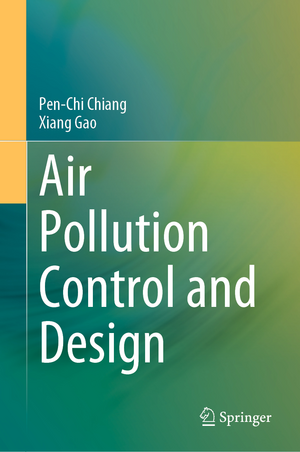Air Pollution Control and Design
Autor Pen-Chi Chiang, Xiang Gaoen Limba Engleză Hardback – 4 oct 2022
Preț: 668.94 lei
Preț vechi: 787.00 lei
-15% Nou
Puncte Express: 1003
Preț estimativ în valută:
127.100€ • 133.65$ • 105.70£
127.100€ • 133.65$ • 105.70£
Carte tipărită la comandă
Livrare economică 15-29 aprilie
Preluare comenzi: 021 569.72.76
Specificații
ISBN-13: 9789811374876
ISBN-10: 9811374872
Pagini: 310
Ilustrații: XIV, 688 p. 408 illus., 133 illus. in color.
Dimensiuni: 155 x 235 mm
Greutate: 1.21 kg
Ediția:1st ed. 2022
Editura: Springer Nature Singapore
Colecția Springer
Locul publicării:Singapore, Singapore
ISBN-10: 9811374872
Pagini: 310
Ilustrații: XIV, 688 p. 408 illus., 133 illus. in color.
Dimensiuni: 155 x 235 mm
Greutate: 1.21 kg
Ediția:1st ed. 2022
Editura: Springer Nature Singapore
Colecția Springer
Locul publicării:Singapore, Singapore
Cuprins
Chapter 1. Air Pollution Control: SOx Control.- Chapter 2. NOx Control.- Chapter 3. VOCs Control.- Chapter 4. PM2.5 Control.- Chapter 5. CO2 Control.- Chapter 6. Fundamentals of Energy Utilization: Sustainable Energy.- Chapter 7. Thermal Dynamics and Heat Transfer.- Chapter 8. Advanced Combustion.- Chapter 9. Energy Materials.- Chapter 10. Integrated Energy Systems.- Chapter 11. Gaseous Control and Design: Adsorption.- Chapter 12. Absorption.- Chapter 13. Combustion.- Stack.- Chapter 14. Particulate Control and Design.- Chapter 15. Cyclone.- Chapter 16. Wet Scrubber.- Chapter 17. Baghouse Filter.- Chapter 18. Electrostatic Precipitator.- Chapter 19. Prospective and Perspective.
Notă biografică
Professor Chiang began engaging in teaching and research activities in National Taiwan University since he obtained Ph.D. degree from the Department of Civil Engineering, Purdue University, USA in 1982. He is a Distinguished Professor of Graduate Institute of Environmental Engineering and a Director of Carbon Cycle Research Center of National Taiwan University. Professor Chiang is known for his work in physicochemical treatment such as carbon adsorption, membrane and ozonation processes. In addition, he was also devoted to his teaching and research in the area of carbon capture technology, air pollution control design and cleaner production technology. He has published more than 300 paper papers in the above area of environmental engineering. Professor Chiang has received numerous awards for research achievements, including Fellow of Water Environment Federation (WEF), BCCE of American Academy of Environmental Engineers and Scientists (AAEES), and Diplomat of the American Academy of Water Resources Engineers of the American Society of Civil Engineers (ASCE), Outstanding Research Contribution Award, Executive Yuan, Outstanding Research Award, National Science Council, and Distinguished Chinese Institute of Engineer Research Award.
Xiang Gao is currently the dean and a professor of the College of Energy Engineering, Zhejiang University, Hangzhou, China, and the director of Coal-Fired Air Pollution Control Engineering Center for Ministry of National Environmental Protection, China. He received his B.S. and Ph.D. degrees from Zhejiang University. His research focuses on simultaneous removal of multi-pollutants (NOx, SOx, particulate matter, and heavy metal, etc.) in flue gas, flue gas desulphurization, flue gas denitration, PM2.5 Control, and energy-saving technology. He has won First prize of the National Award for Technological Invention, Second prize of the National Award for Scientific and Technological Progress, Second prize of the National Award for Technological Invention, Second prize of the National Award for Teaching Achievements, the Chinese Outstanding Patents Award, etc. He has published more than 200 peer-reviewed papers, more than 60 invention patents (including 3 international patents) and involved in more than 30 authorized national/industrial standards as a leading or important role.
Textul de pe ultima copertă
This book focuses specifically on the environmental issues related to the air pollution control and design. It is divided into four parts: (1) Fundamentals of air pollution control, (2) fundamentals of energy utilization, (3) gaseous control and design, and (4) particulate control and design, each consisting of four to six chapters. The topics covered in this book not only introduce the basic concepts of air pollution control and design but also address the fundamentals of energy utilization in the context of good engineering practice and policy instruments. It also features several innovative technologies and integrated methodologies relating to gaseous and particulate matter control and design. To facilitate technology integration and meet the need for comprehensive information on sustainable development, the book discusses a wide range of areas concerning the principles, applications, and assessment of air pollution control and design and thermodynamics, heat transfer, advanced combustion and renewable energy for energy utilization. It also features regulations and policy instruments adopted around the globe as well as several case studies. Presenting the emerging challenges, new concepts, innovative methodologies, and resolving strategies, as well as illustrative and inspiring case studies, it appeals to a wide range of readers, such as researchers, graduate students, engineers, policy makers, and entrepreneurs.
Caracteristici
Offers an extended review of energy utilization technologies for integrated energy systems Presents several gaseous pollutant control technologies and design criteria in industry Illustrates the major equipment for particulate matter control and design
